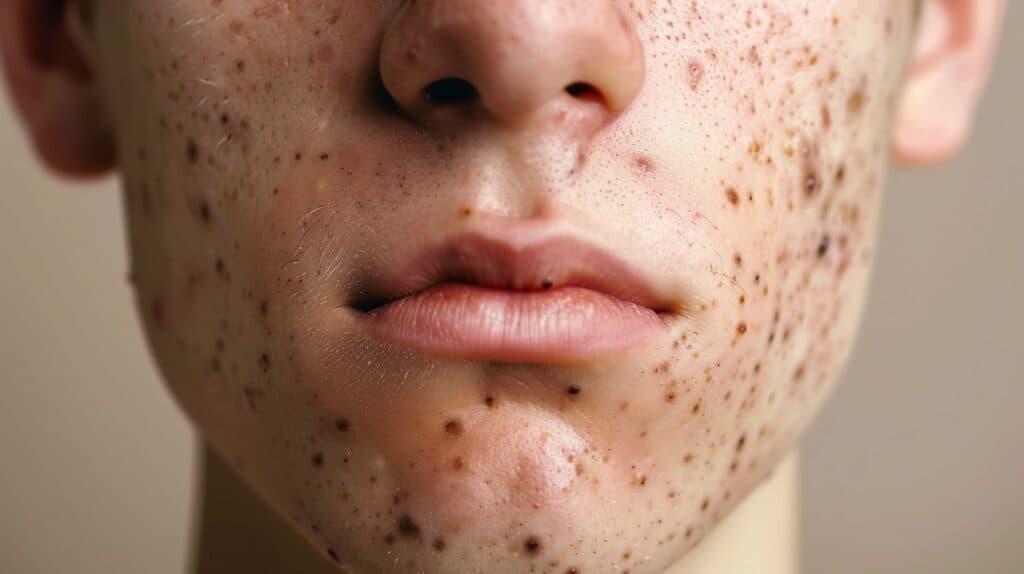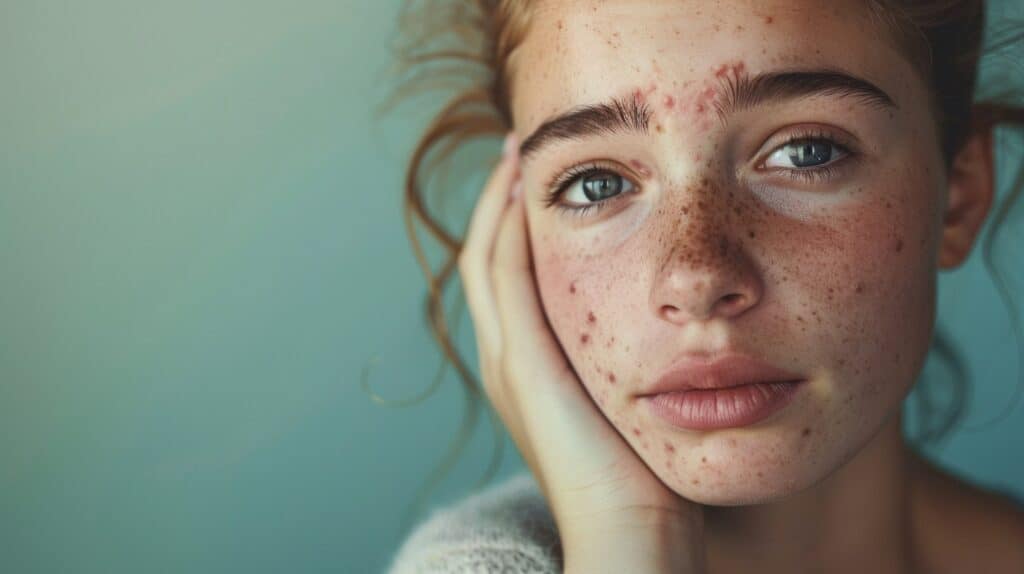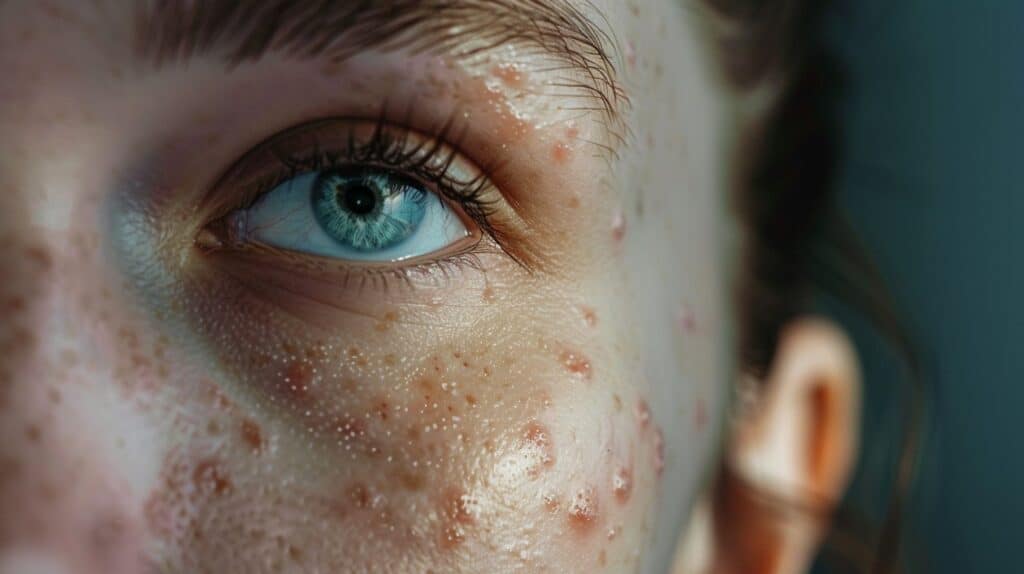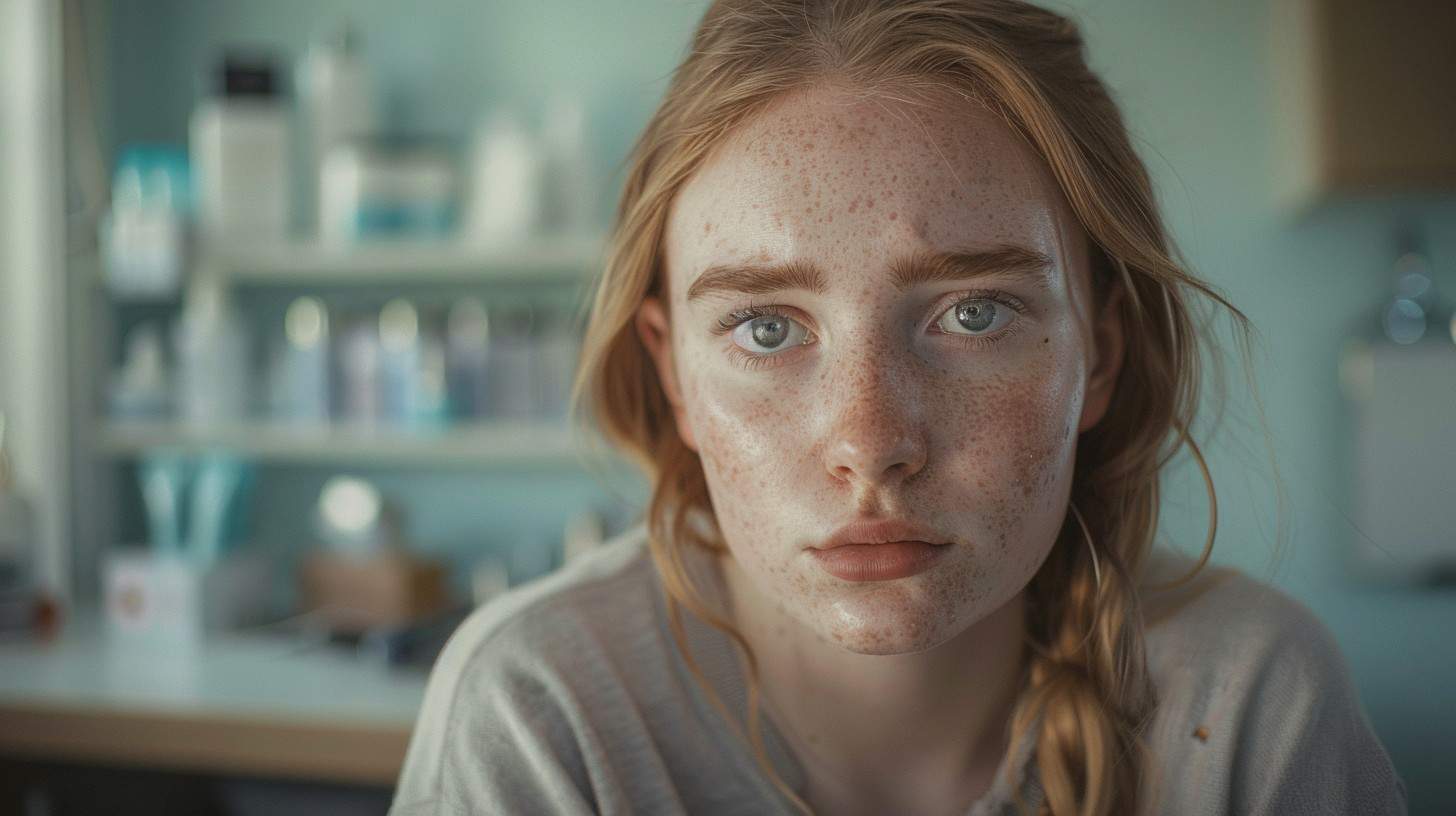Acne can be a frustrating, confidence-draining experience – no matter your age. Hormonal fluctuations are a major culprit behind those pesky pimples popping up. But don’t worry, this guide has your back – outlining acne’s age patterns and providing tips to keep breakouts at bay.
Ready to banish blemishes? Let’s get started!
Key Takeaways
Acne is often worst during the teenage years due to hormonal changes associated with puberty, but it can also persist or develop in adulthood for some individuals.
Factors contributing to acne include hormonal fluctuations, genetics, stress, diet, certain medications, and environmental factors like pollution and humidity.
Treatment options for acne range from over-the-counter products containing ingredients like benzoyl peroxide, salicylic acid, and retinoids, to prescription topical treatments and oral medications such as antibiotics, birth control pills, and isotretinoin for severe cases.
Seeking guidance from a dermatologist is crucial for developing an effective, personalized treatment plan based on the individual’s age, acne severity, and unique skin characteristics.
Consistency and patience are key when using acne treatments, as it may take several weeks to see noticeable improvements.
Table of Contents
Understanding Acne: Causes and Impacts

Hormonal fluctuations during puberty trigger excess oil production, clogging pores and sparking breakouts.
But acne can also stem from genetics, stress, diet, and certain medications.
When it comes to the age acne is worst, there’s no one-size-fits-all answer. Teen years are notorious for raging hormones and neck acne. Yet for some, adult acne rears its ugly head – women may battle hormonal breakouts around their periods or during major life transitions.
Guys aren’t immune either – male hormones can instigate acne well into adulthood.
The Role of Puberty and Hormones in Acne Formation
Puberty triggers a surge of hormones — especially testosterone — that stimulate oil glands, leading to excessive sebum production and acne breakouts. This explains why most people suffer from acne during their teenage years.
Testosterone causes the sebaceous glands to enlarge and secrete more oily sebum that can clog pores.
As hormone levels fluctuate during puberty, the skin’s oil production goes into overdrive — causing blackheads, whiteheads, pimples, and cysts. While hormone changes are a natural part of development, they wreak havoc on the skin and pave the way for acne.
Genetic Factors in Acne Development
Hormones spur acne, but genetic blueprints determine severity. Genes shape testosterone impact—influencing oil glands and irritation. They also impact bacterial strains on skin. Understanding genetics guides treatment plans… some respond better to certain medications based on their DNA.
Genetics even influence scarring risk—a concern many men face. Consulting a dermatologist unveils your unique acne code—key to clearing skin.
Dermatologists decode DNA’s role in breakouts. For some guys, genes amplify testosterone effects—causing oilier skin, clogged pores, and angry pimples. Others genetically lack protection against acne-causing bacteria… leading to inflamed lesions.
Additional Factors that Contribute to Acne
Genetics plays a significant role – if your parents battled acne, you’re more likely to develop it too. Stress exacerbates breakouts by increasing hormone levels… think final exams or job interviews.
Using greasy hair products or cosmetics can clog pores and worsen acne. Diet may influence severity – some studies link dairy, high-glycemic foods, and whey protein to increased breakouts.
Medications like anabolic steroids, lithium, and corticosteroids are notorious acne triggers. Don’t sleep in sweaty clothes post-workout – that dirt and bacteria feast on your pores.
Age and Acne: When is it the Worst?

For many people, acne is most severe during the teenage years — those awkward, hormone-fueled days filled with angst and insecurity. But for some unlucky souls, acne lingers well into adulthood… even after they’ve bid farewell to adolescence.
During puberty, surging androgens (male sex hormones) overstimulate the sebaceous glands — tiny factories that pump out skin oils. An excess of this oily sebum clogs pores, providing the perfect environment for acne-causing bacteria to flourish… and pimples, blackheads, and cysts to emerge.
Acne in Adolescents
Teenage acne is no joke – it hits hard during puberty’s raging hormones. As boys transform into men, testosterone surges fuel greasy sebum production, clogging pores. Breakouts erupt like volcanic zits, leaving emotional scars.
Adolescence breeds the perfect acne storm – oily skin, rampant androgens, and clogged hair follicles. Cheeks, nose, and forehead become battlegrounds for blackheads, whiteheads, and inflamed pimples.
Brace yourself, this pimply phase can linger for years without intervention. But fret not, we’ll explore treatments to fight teenage eruptions.
Acne in Teenage Years
Teen acne strikes hard—hormonal upheavals unleash a surge of oil production, clogging pores and fueling bacterial overgrowth. This perfect storm often peaks around 14–19 years old, leaving many young men waging war against pimples.
Fluctuating testosterone levels supercharge oil glands, while stress and genetics play accomplices in the breakout battle. It’s a frustrating rite of passage, but the right skincare routine—cleansers, creams, even medications—can help turn the tide.
Hang in there, guys… adult acne awaits.
Acne in Adults
During teenage years, hormonal fluctuations and puberty fuel acne breakouts — but the skin problems don’t necessarily end there. Adult acne is shockingly common, affecting up to 15% of women.
For men, hormonal imbalances due to stress, certain medications, or underlying conditions like polycystic ovary syndrome spark fresh breakouts well into adulthood.
Genes also play a role — if your parents battled acne, you’re more prone to it persisting beyond your teens. And while teenage breakouts clustered on the face, adult acne frequently strikes the back, shoulders, and chest too.
Treatment Options for Different Stages of Acne

Treatment Options for Different Stages of Acne: From over-the-counter creams and gels to prescription medications like Isotretinoin – the options are diverse, tailored to your age and acne severity.
But don’t worry, we’ve got you covered with the right approach… and trust us, you’ll want to read on!
Over-the-Counter Treatments
Over-the-counter acne treatments offer a convenient starting point. Here are some options:
- Benzoyl peroxide eliminates acne-causing bacteria — a potent weapon against pimples. However, it can cause dryness and irritation. Begin with a lower concentration.
- Salicylic acid sloughs off dead skin cells, preventing pores from clogging. It’s best for blackheads and whiteheads. Avoid using it on sensitive areas.
- Sulfur dries out oily spots, reducing breakouts. Some find the smell unpleasant, though. Try a lower dose if irritation occurs.
- Retinoids, derived from vitamin A, regulate skin cell turnover. They treat blackheads while preventing new pimples. Prepare for some temporary peeling.
- Alpha hydroxy acids exfoliate to clear clogged pores. Glycolic and lactic acids are common choices — proceed cautiously if you have sensitive skin.
- Tea tree oil has antibacterial properties for spot-treating pimples. Use sparingly, as it can dry out skin.
Consistency trumps everything — these treatments require weeks for full effects. Don’t give up too quickly. If over-the-counter products fail, prescription meds may be necessary. A dermatologist can customize a tailored regimen for your unique skin.
Topical Treatments
Dealing with acne requires a multipronged approach. Topical treatments play a pivotal role in managing breakouts.
- Benzoyl peroxide: This powerful ingredient kills acne-causing bacteria, dries out excess oil. It’s available over-the-counter in varying strengths — start with a lower concentration to avoid irritation.
- Retinoids: These vitamin A derivatives unclog pores, preventing new breakouts. Tretinoin (prescription-strength) and adapalene (available OTC) are popular choices. Expect some dryness and peeling initially.
- Salicylic acid: Found in many OTC products, it exfoliates skin, unclogs pores. Great for blackheads and whiteheads.
- Sulfur: An underrated ingredient that dries out pimples, reduces oiliness. Can cause temporary discoloration on skin.
- Azelaic acid: Naturally occurring, this acid has antimicrobial properties. It’s gentle yet effective for inflammatory acne.
- Dapsone: A prescription gel that fights inflammation, kills bacteria. Works well for adult female acne.
The key? Different products work better for different acne types and locations — don’t be afraid to experiment under a dermatologist’s guidance. Proper application and patience are vital for topicals to zap zits. Next up: Oral medications and their role in acne management.
Oral Medications
Oral medications play a pivotal role in managing severe acne cases. Here’s the lowdown:
- Antibiotics – Heavy-hitters like tetracycline, minocycline, and doxycycline are go-to prescriptions for moderate to severe acne. They zap those pesky pimple-causing bacteria.
- Birth control pills – For women, these handy helpers can regulate hormonal imbalances that fuel breakouts. A win-win for clearer skin and menstrual cycle management!
- Isotretinoin – This powerful oral med is the nuclear option for stubborn cystic acne. But it’s not without side effects, so close monitoring is key.
- Anti-androgen drugs – Guys, these bad boys like spironolactone can curb excess male hormones (androgens) that ramp up oil production and ignite breakouts.
- Consult a dermatologist – Don’t self-medicate! Oral acne meds require professional supervision to maximize results and minimize risks. Your derm’s got your back(ne)!
Remember, oral medications demand commitment – follow dosage instructions to a T. But with the right regimen, you could be well on your way to clearer, more confident skin. Don’t let acne cramp your style!
FAQs About What Age Acne is the Worst
When does acne typically start and peak?
Acne often rears its ugly head during the teenage years, thanks to hormonal changes that crank up oil production in those sebaceous (oil) glands. But don’t be fooled – acne can strike at any age, even in tweens or after menopause. The peak pimple years are usually in the late teens, but some folks battle breakouts well into early adulthood.
Why do some adults still struggle with acne?
For some unlucky souls, acne is the pimple that keeps on giving. Adult acne can be triggered by hormonal factors like menstrual cycles, pregnancy, polycystic ovary syndrome (PCOS), or just good ol’ genetics. Stress doesn’t do your skin any favors, either. The bottom line? Acne doesn’t automatically disappear after high school for everyone.
What are the different types of acne lesions?
Acne comes in many shapes and sizes – from whiteheads and blackheads (known as comedones) to angry red pimples (pustules) and even painful cysts deep under the skin. Some lesions are just an annoyance, while others can lead to scarring if not treated properly. Know thy enemy!
How can I prevent acne scars?
An ounce of prevention is worth a pound of cure when it comes to acne scarring. Don’t pick, pop, or squeeze those pimples – that can lead to infection and worsen scarring. See a dermatologist for professional treatments like chemical peels, light therapy, or even skin surgery for severe cases. And hands off that face!
Are there any home remedies for acne?
While over-the-counter acne meds can help, some natural remedies may give you a hand in the battle too. Tea tree oil has anti-inflammatory properties, and exfoliating with a soft brush can clear out those clogged pores. But don’t go overboard – too much scrubbing can irritate skin. Moderation is key.
When should I see a dermatologist for acne?
If your acne is severe, persists into adulthood, or starts causing physical scarring or emotional distress, it’s time to call in the professionals. A dermatologist can prescribe potent acne meds, hormonal treatments like oral contraceptives, or discuss other options to get your skin glowing again. Don’t suffer in silence!



